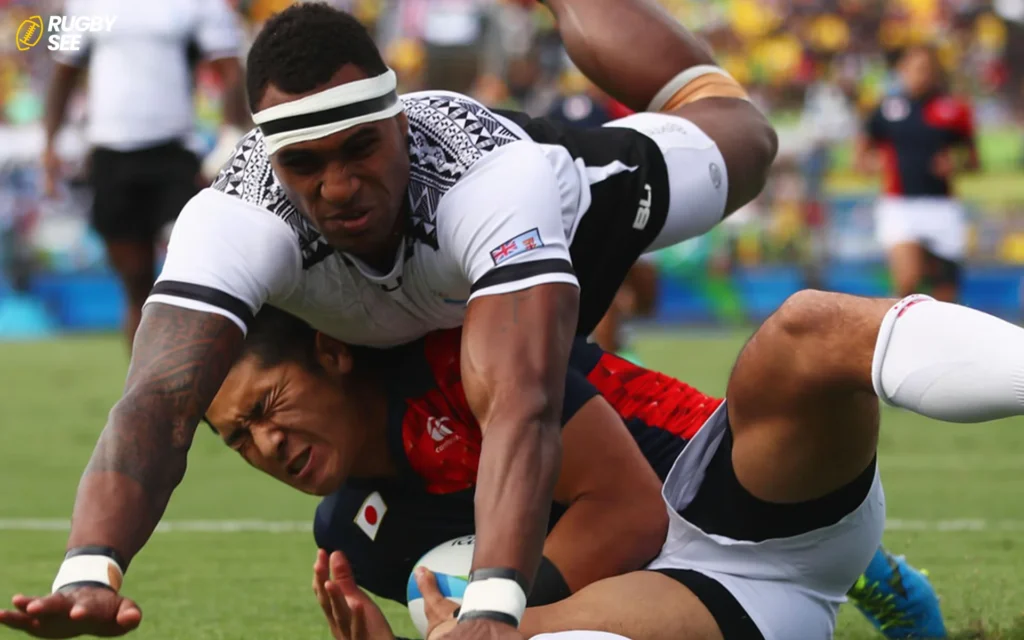In the rough world of rugby, where physical toughness is as much a part of the game as the ball itself, players often take to the field with different types of protective gear. One of the most interesting, and perhaps most visually confusing for newcomers, is seeing players with their heads stuck in tape. Far from being just a fashion statement or a fancy ritual, this practice serves several important purposes, all of which aim to minimize the risk of injury and increase performance. So, why exactly do rugby players tape their heads? Let’s take a look at the reasons with Rugbysee behind this attractive aspect of rugby wear with Rugby.
The Protective Shield: Understanding Head Taping
Rugby, known for its high-impact collisions and physical intensity, naturally carries a risk of injury. Head taping, primarily, serves as a protective measure. The tape used is not ordinary adhesive tape but a specialized kind designed to provide a layer of protection to the player’s ears and forehead, areas particularly vulnerable during scrums, rucks, and mauls.
- Scrum Caps vs. Head Taping: While some players opt for scrum caps, others prefer the less bulky, more customizable protection offered by head tape. This preference underscores the tape’s role in injury prevention, specifically against superficial cuts and abrasions, and in some cases, offering a modest buffer against concussions.
Enhanced Grip: The Unseen Advantage
Another less apparent reason for head taping involves the grip. During scrums, players interlock with teammates and opponents alike, pushing against each other with considerable force. The tape provides an additional grip surface, reducing the likelihood of hands slipping off, which can lead to neck injuries or lessen the effectiveness of the scrum.

Psychological and Team Dynamics
- Mental Edge: For some players, head taping is as much a psychological tool as it is a physical one. The ritual of taping can serve as a mental preparation, a physical manifestation of the readiness to enter the battle. This mental aspect, while less tangible, can provide a significant performance boost.
- Team Identity: Rugby is a sport steeped in tradition and team spirit. Customized tapes, colors, and patterns can signify team identity or honor a cause, contributing to the unity and camaraderie essential in rugby’s team-centric culture.
Injury Mitigation and Recovery
Players recovering from head injuries may use tape as an added layer of protection, complementing medical advice and recovery protocols. It’s important to note, however, that while tape can aid in the prevention of minor injuries, it is not a substitute for proper medical treatment or a cure-all for preventing concussions.
A Nod to Tradition
Rugby’s rich history is filled with rituals and traditions, and head taping, for some, is a nod to the sport’s rugged, no-holds-barred nature. This tradition of head taping, passed down through generations, carries with it a sense of belonging and a link to the sport’s storied past.
Considerations and Controversies
While head taping is widely accepted, it’s not without its controversies. The effectiveness of tape in preventing serious injuries, such as concussions, is debated. Critics argue that reliance on tape might give players a false sense of security. This underscores the importance of ongoing research and adherence to evolving safety guidelines.
Certainly, let’s delve deeper into some additional facets surrounding the practice of head taping in rugby, further enriching our understanding and discussion and if you want to know about the popularity of Rugby in Europe read Which rugby is more popular in europe.
The Evolution of Head Taping in Rugby
Over the years, the materials and techniques used for head taping have seen significant advancements. Initially, players used basic medical tape, which offered minimal protection and had a tendency to come loose during play. Today, the advent of more sophisticated materials, including highly adhesive, flexible, and durable tapes, has enhanced the effectiveness and comfort of head taping.
The Role of Technology and Innovation
The intersection of technology and sports science has also played a pivotal role in evolving the practice of head taping. Modern tapes are designed not just for protection but also to conform to the player’s head shape, ensuring a snug fit that doesn’t compromise comfort or hinder performance. Some tapes even incorporate breathable materials to help manage sweat, a small but critical consideration during intense physical exertion.

Education and Awareness
As awareness of sports-related injuries, particularly concussions, has increased, so has the focus on preventive measures in rugby. Educational programs aimed at players, coaches, and medical staff highlight not only the benefits but also the limitations of head taping. Such initiatives emphasize that while head taping can play a role in injury mitigation, comprehensive strategies, including proper tackling techniques and rigorous concussion protocols, are paramount.
The Future of Head Taping
Looking forward, the practice of head taping in rugby may continue to evolve. Ongoing research into injury prevention and performance enhancement could lead to new materials or taping techniques. Furthermore, the growing emphasis on player safety might spur innovations that offer greater protection, potentially incorporating smart technologies that can monitor impact or stress levels in real time and if you want to know about the point of Scrums in rugby read What Is the Point of a Scrum in Rugby.
The Broader Impact on Rugby Culture
Head taping, beyond its practical applications, has become a symbol of the toughness and camaraderie that rugby is known for. It represents a physical and mental commitment to the game and to one’s teammates. This cultural aspect, intertwined with the functional benefits of head taping, underscores the practice’s enduring presence in the sport.

Personalizing the Practice
Players often personalize their head taping, whether through specific wrapping styles or by incorporating team colors. This personal touch adds a unique visual element to the game and allows players to express their individuality while adhering to a shared tradition.
The practice of taping heads in rugby is a multifaceted tradition that spans practical, psychological, and cultural dimensions of the sport. From providing a physical barrier against minor injuries to enhancing team unity and mental preparedness, the reasons behind head taping are as complex as the game of rugby itself. As the sport continues to evolve, so too will the approaches to player safety and performance, with head taping remaining a visible, intriguing part of rugby’s fabric.
As rugby enthusiasts and players alike debate the merits and methods of head taping, one thing remains clear: the well-being of the players is paramount. Through a combination of tradition, innovation, and scientific inquiry, rugby continues to navigate the fine balance between maintaining its essence and ensuring the safety of those who play it.










